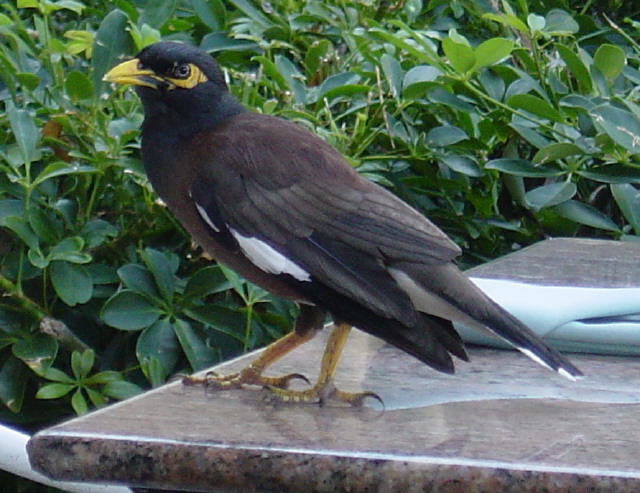- Acridotheres
Taxobox
name = "Acridotheres "

image_width = 250px
image_caption =Common Myna , "Acridotheres tristis"
regnum =Animal ia
phylum =Chordata
classis =Aves
ordo =Passeriformes
familia =Sturnidae
genus = " Acridotheres "
genus_authority = Vieillot,1816
subdivision_ranks = Species
subdivision = Some 12-16, see text"Acridotheres" is a
genus ofstarling s, the "typical"myna s, which are tropical members of the family Sturnidae. This genus has representatives in tropical southernAsia fromIran east to southernChina andIndonesia . Two species have been introduced widely elsewhere. The Common Myna has been introduced toSouth Africa ,Israel ,Hawaii ,North America ,Australia andNew Zealand , and the Crested Myna to the Vancouver region ofBritish Columbia .The "Acridotheres" mynas are generally dark or dull birds with and fluted calls like most starlings; the sexes are similar. They walk rather than hop, and have modifications to the skull and its muscles for open bill probing. They resemble the hill mynas ("
Gracula ") with which they often co-occur, in having large white or buff wing patches which are obvious in flight and in some also naked areas on the head, but differ in that only the head plumage is glossy, and the underparts tend to be paler. The naked head patches are different in arrangement. "Acridotheres" mynas are also much more terrestrial than "Gracula".They have bowing courtship displays, whereas "Gracula" has no visual display. They lay unmarked pale blue eggs.
Several species have frontal crests which become covered with pollen when the birds take nectar from flowers, and may play a role in pollination.
Like most starlings, the "Acridotheres" mynas are fairly omnivorous, eating
fruit ,nectar andinsect s.ystematics
Despite being both called "mynas", the "Acridotheres" mynas are closer related to a group of mainly terrestrial starlings from
Eurasia , such as theCommon Starling , and alsoAfrican ones like the "Lamprotornis " glossy-starlings. Among these, they are among the larger and duller species; they seem to be one of the major groups toevolve most recently. Apparently, they all arose from ancestors which arrived fromCentral Asia and adapted to morehumid conditions in theTropics . They presumably were isolated in about their current range when theevolutionary radiation to which they belonged - including theWattled Starling and the "Sturnia " species - was fragmented bydesertification of their of origin at the start of theEarly Pliocene , as Earth turned towards thelast ice age 5 million years ago.The
taxonomy of this group is complex, and other authorities differ considerably in which species they place in this genus, and in the species boundaries within "Acridotheres".The following is a list of "core" "Acridotheres" species in taxonomic orderFact|date=July 2007:
*
White-vented Myna , "Acridotheres grandis"
*Crested Myna , "Acridotheres cristatellus"
*Javan Myna , "Acridotheres javanicus"
*Pale-bellied Myna , "Acridotheres cinereus"
*Jungle Myna , "Acridotheres fuscus"
*Collared Myna , "Acridotheres albocinctus"
*Bank Myna , "Acridotheres ginginianus"
*Common Myna , "Acridotheres tristis"The taxonomy of this group is complex, and other authorities differ considerably in which species they place in this genus, and in the species boundaries within "Acridotheres". Several species from the
paraphyletic "Sturnus " assemblage are often placed in "Acridotheres". Indeed, as more recent studies suggest (Jønsson & Fjeldså 2006, Zuccon et al. 2006), this is most likely correct.*
Vinous-breasted Starling , "Sturnus burmannicus" - alternatively united in "Gracupica" withBlack-collared Starling
*Asian Pied Starling , "Sturnus contra"
*Black-winged Starling , "Sturnus melanopterus"
*Red-billed Starling , "Sturnus sericeus"
*White-cheeked Starling , "Sturnus cineraceus"The last two are probably rather basal in the entire group and might even be closer to "
Sturnia ". The relationships of theWhite-faced Starling are more unclear, but it is generally not held to be close to the present genus.References
* (1999): "Starlings and Mynas". Princeton University Press. ISBN 0-7136-3961-X
* (1999): "Birds of India, Pakistan, Nepal, Bangladesh, Bhutan, Sri Lanka, and the Maldives". Princeton University Press, Princeton, N.J.. ISBN 0-691-04910-6
* (2006): A phylogenetic supertree of oscine passerine birds (Aves: Passeri). "Zool. Scripta" 35(2): 149–186. doi|:10.1111/j.1463-6409.2006.00221.x (HTML abstract)
*aut|Zuccon, Dario; Cibois, Anne; Pasquet, Eric & Ericson, Per G.P. (2006): Nuclear and mitochondrial sequence data reveal the major lineages of starlings, mynas and related taxa. "Molecular Phylogenetics and Evolution" 41(2): 333-344. doi|10.1016/j.ympev.2006.05.007 (HTML abstract)
Wikimedia Foundation. 2010.
